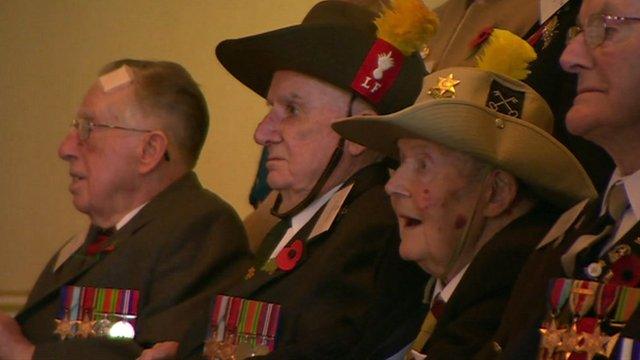Kohima: Britain's 'forgotten' battle that changed the course of WWII
- Published

View of the Garrison Hill battlefield with the British and Japanese positions shown. Garrison Hill was the key to the British defences at Kohima.
Captain Robin Rowland was 22 when his regiment was deployed to the north-eastern Indian town of Kohima. It was May 1944, and a small group of British-Indian soldiers was under assault by an entire division of Japanese forces.
Capt Rowland, now 99, vividly remembers approaching the town, following a trail of devastation to the front line.
"We saw abandoned trenches and destroyed villages, and as we moved forward the smell of death was everywhere," he said.
The young captain was a member of the Punjab regiment of the British Indian army, on his way to help relieve 1,500 of his fellow soldiers who had spent weeks resisting 10 times their number in Japanese forces.
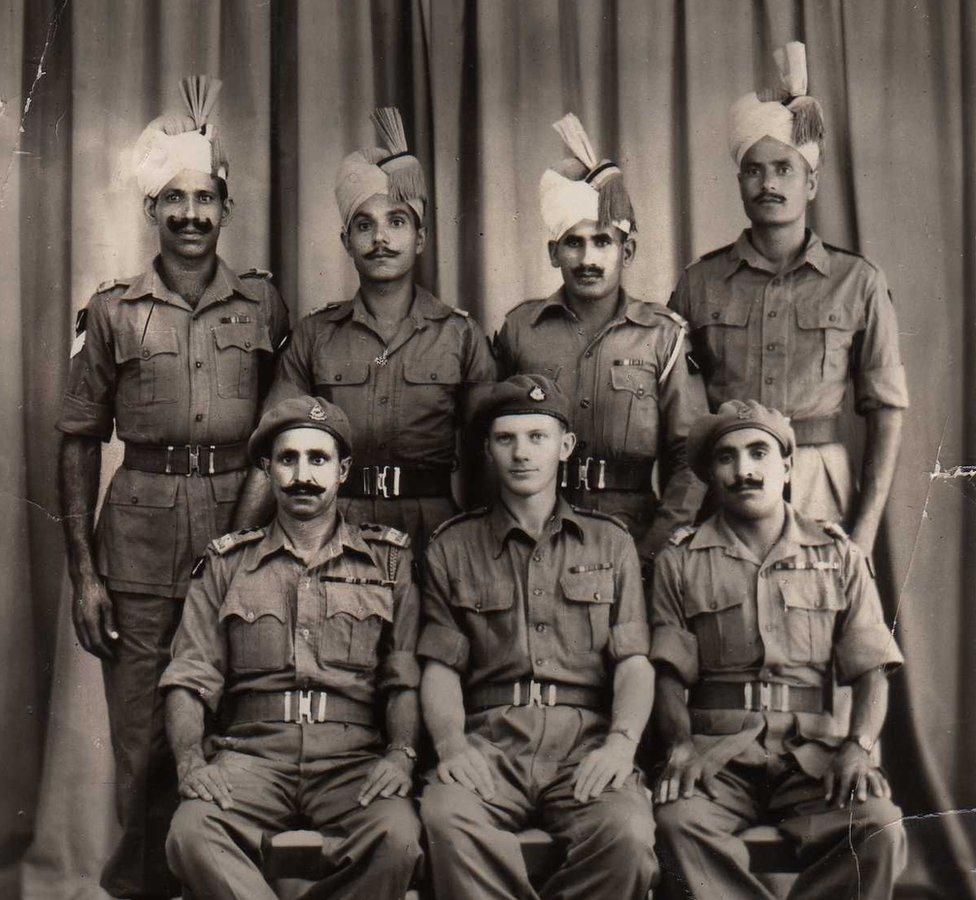
Robin Rowland sits with members of the Punjab regiment for a photo after the Japanese defeat
Cut off by the Japanese, the allied forces were depending solely on supplies by air, and very few believed they could withstand the relentless onslaught. Japan's soldiers had marched to Kohima through what was then Burma - their aim to invade India.
The Japanese had already routed the British in Burma, but no-one expected them to successfully negotiate the mosquito-infested jungle hills and fast-flowing streams en route to Kohima, the capital of Nagaland, and Imphal, the capital of Manipur state in India.


When they did, the British-Indian troops tasked with defending the two towns were surrounded by more than 15,000 Japanese soldiers. They fought for weeks to prevent the Japanese moving through and capturing the strategic city of Dimapur, which could have opened the routes to the plains of Assam. Few believed the defenders could prevail.
The Japanese soldiers came in "wave after wave, night after night", recalled Capt Rowland.
The fighting was brutal and the British-Indian forces were confined to Garrison Hill, which overlooked Kohima. At one point the fighting descended into hand-to-hand combat, with only a tennis court separating the two sides dug in on the hill.
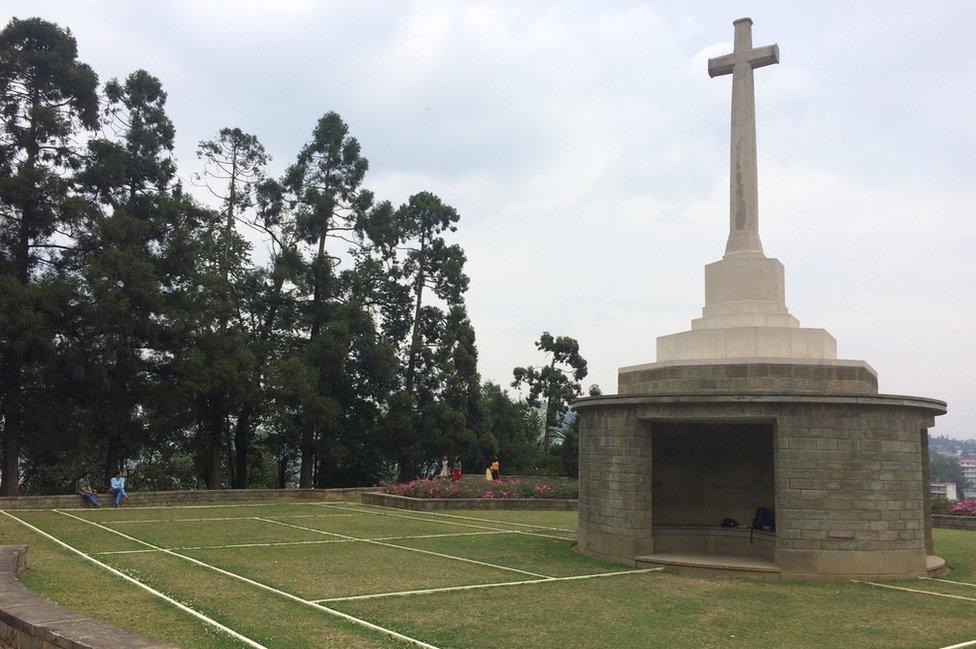
The tennis court on Garrison Hill was all that divided the two armies
The besieged British-Indian soldiers held on until the reinforcements arrived. After three months, by June 1944, with more than 7,000 casualties and almost no food supplies left, the Japanese division retreated and returned to Burma, despite orders from above to stay and fight.
"It was a terrific resistance by 1,500 British-Indian troops," Capt Rowland said. "If the Japanese had taken Garrison Hill, they would have gone to Dimapur."
The British-Indian forces were ordered to pursue the retreating Japanese and Robin Rowland was among the pursuers. Some of the Japanese soldiers died of cholera, typhoid and malaria, but by far the greater number perished due to starvation as they ran out of supplies.

Men of the Royal West Kent Regiment pay silent tribute to comrades who fell in the Battle for Kohima, in November 1945
According to military historian Robert Lyman, the battle "changed the course of the Second World War in Asia".
"The Japanese invasion of India, of which the battle of Kohima was a significant part, was [their] first major defeat in the Far East," he told the BBC.
But, although it was a turning point, the battle in north-east India never captured the public imagination in the way that D-Day, Waterloo or other battles in Europe and North Africa had.
It has often been described as "the forgotten war".
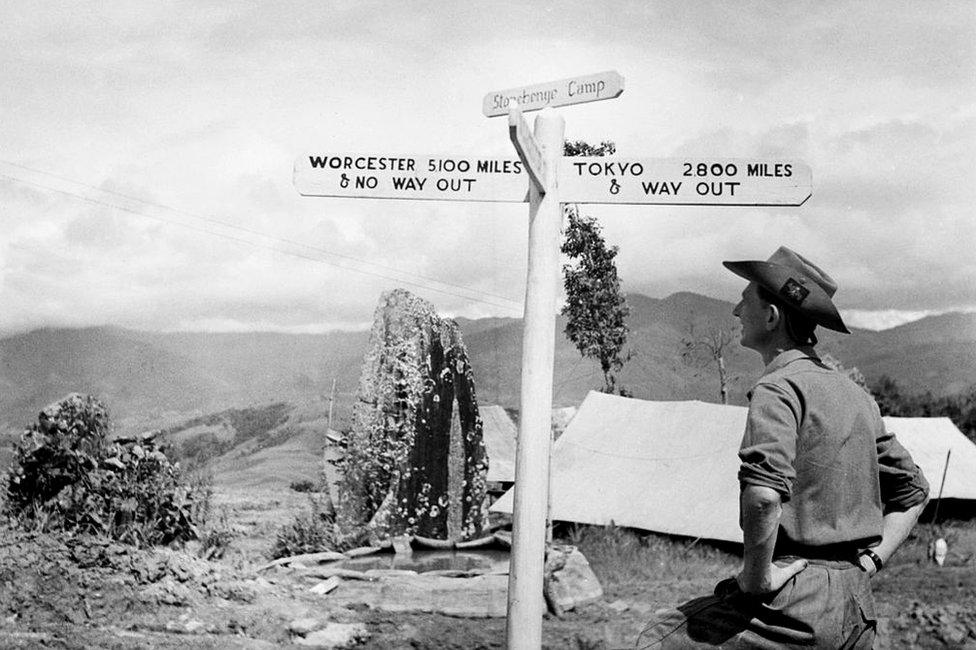
A British soldier views a road sign on the crucial Imphal to Kohima road in 1944
People in Britain were simply too far away for it to register as much, according to Bob Cook, the head of the Kohima Museum in the city of York.
"The Germans were just across 22 miles of water from Britain," he said. "The thing that most concerned people of this country was the imminent threat of German invasion."
But there have been some attempts to teach people about the Battle of Kohima and Imphal. In 2013, it was voted as Britain's greatest battle after a debate at the National Army Museum in London, a surprise winner over the likes of D-Day and Waterloo.
Robert Lyman made the case for Kohima. "Great things were at stake in a war with the toughest enemy any British army has had to fight," he said in his speech.
But there has hardly been any attempt in the sub-continent to highlight the importance of the battle, in which thousands of Commonwealth and Indian soldiers - including men from modern-day India, Pakistan and Bangladesh - lost their lives.
How the battle of Kohima and Imphal changed the fortunes of British-led forces in Asia in WW2
One reason was the British partition of India soon after, according to Charles Chasie, a historian based in Kohima in Nagaland.
"One of the reasons I think was that India's leaders were too busy dealing with the effects of transition and partition initially," he said. "The British had decided to leave in a hurry before things got too complicated and out of hand on the sub-continent."
The battle of Kohima was seen more as a colonial war, while the post-war discourse focused more on the Indian independence struggle led by the Indian leader, Mahatma Gandhi.
In addition to the regular British-Indian army, thousands of people from the Naga ethnic community fought alongside the British and provided valuable intelligence in the conflict. Their in-depth knowledge of the mountainous territory was of great help to the British.
Today, only a dozen or so Nagas who lived through the battle of Kohima are still alive. Sosangtemba Ao, is one of them. He was among those enlisted by the British Army to cut the Burma road.
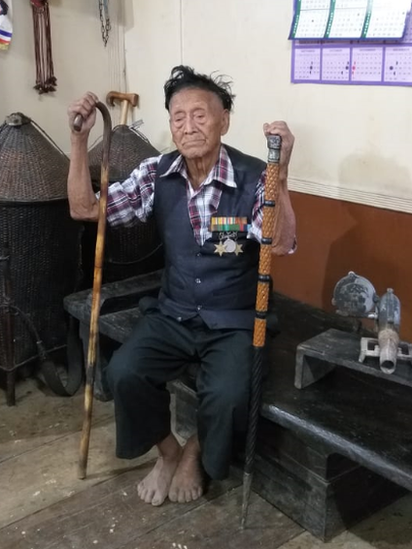
Sosangtemba Ao said the Japanese soldiers did not fear death

"The Japanese bombers were flying every day dropping explosives. The sound was deafening and there was smoke after each attack. It was distressing," recalled Mr Ao.
He worked alongside the British for two months for pay of one rupee per day. He still has a lot of admiration for the fighting ability of the Japanese soldiers, he said.
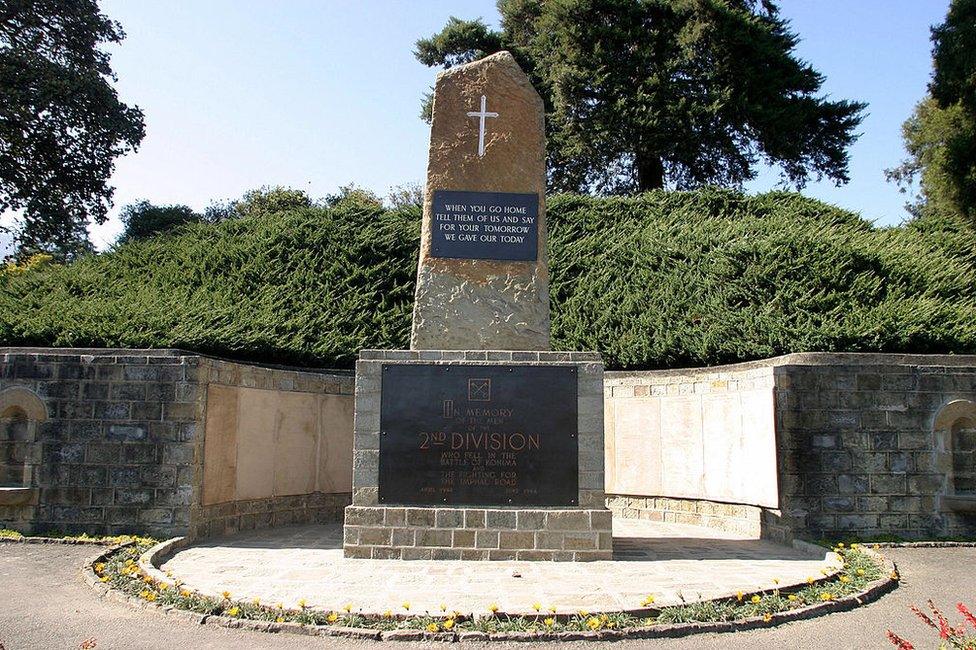
The memorial to the dead at Kohima War Cemetery
"The Japanese army was highly motivated. Their soldiers did not fear death. For them, fighting for the emperor was divine. When they were asked to surrender, they would become suicide attackers."
A documentary about the battle, Memories of a Forgotten War, external, was released online recently to coincide with the 75th anniversary of the Japanese surrender. Several years ago producer Subimal Bhattacharjee and the crew travelled to Japan for a commemoration.
"When the Japanese and the British veterans of Kohima met, they hugged each other and started crying," he said. "These were the soldiers who had fired at each other, but still they showed a special bond. It was spontaneous and we didn't expect it."
For the Japanese, it was a humiliating defeat, and Japanese veterans rarely talk about their experience in Kohima.
"None of the Japanese food was left," said one, Wajima Koichiro, who was interviewed for the documentary. "It was a losing game and then we withdrew."
The ethnic Nagas, who aided the British and suffered huge casualties, also continued to suffer. They had hoped that the British would recognise them as a separate Naga nation during the handover of power, and not as part of India. But they were "sorely disappointed", said historian Charles Chasie, and many blamed them for the thousands of Nagas who were killed in subsequent conflicts with the Indian government and army.
Over the years, the families of those killed at Kohima and Imphal, especially from Britain and Japan, have travelled to the two war cemeteries there to pay respects to their ancestors.
Capt Rowland went back to Kohima with his son in 2002 at the invitation of the Indian Punjab regiment. He stood in front of Garrison Hill, where he and his fellow soldiers had resisted the waves of Japanese fighters 58 years earlier.
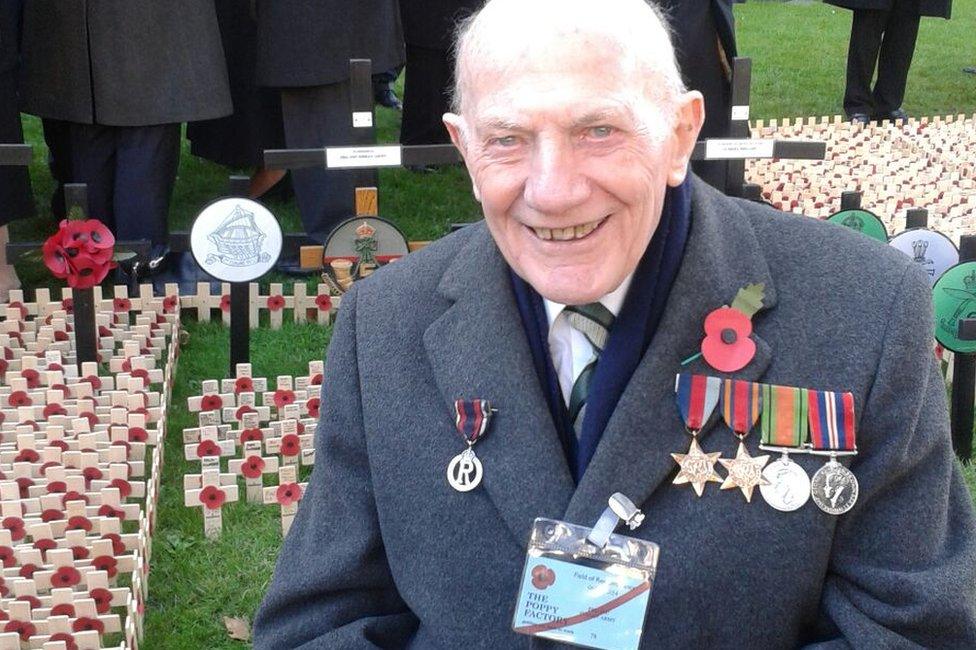
Robin Rowland at the Fields Of Remembrance service at Westminster Abbey on 6 November 2014
"It brought back many memories," said Capt Rowland, remembering how a group of 1,500 men had stood against the might of the entire Japanese 31st division. "It was a great military achievement."
Before leaving Kohima, Capt Rowland and his son stopped to lay a wreath at the base of the rough stone war memorial on Garrison Hill. As he put the wreath in place, he remembered eight fellow soldiers he had known who were lost.
He knew the battle had not entered the public imagination in the way more famous battles had, but those who were there would never forget.
"It was a great tribute to the resilience of human nature," he said.
Related topics
- Published17 June 2015
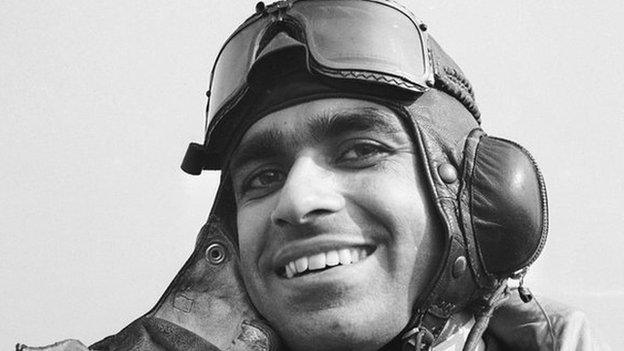
- Published9 November 2012
